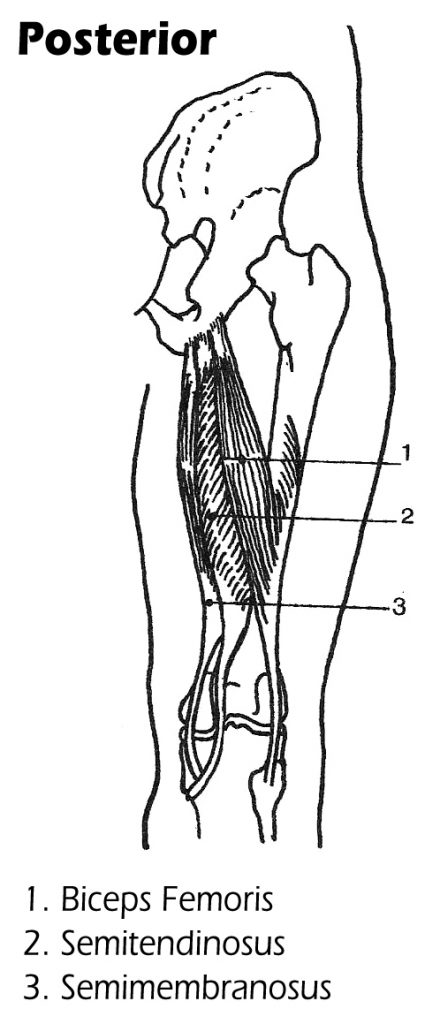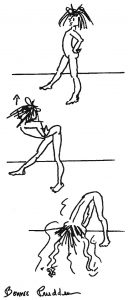 Hamstring, by definition, refers to any of the five tendons associated with the muscles in the back of the thigh. It is also the term most often used to refer to the muscles themselves. These muscles are semitendinosus, semimembranosus, and biceps femoris. Since they cross both the hip and knee joints they are responsible for bending and straightening the hip and knee and are therefore in play during movement such as walking, running and jumping
Hamstring, by definition, refers to any of the five tendons associated with the muscles in the back of the thigh. It is also the term most often used to refer to the muscles themselves. These muscles are semitendinosus, semimembranosus, and biceps femoris. Since they cross both the hip and knee joints they are responsible for bending and straightening the hip and knee and are therefore in play during movement such as walking, running and jumping
Hamstrung, by definition and in the literal sense, refers to a method of crippling or incapacitating a person or animal so that it cannot walk properly by severing the hamstring tendons. As a figure of speech “to be hamstrung” (according to Wikipedia) suggests being limited in a way that prevents full freedom of movement or utilization of resources.
You have only to read the sports page to know how often the hamstrings are responsible for sidelining the greats and not so greats of the sport arenas. The injury sustained can be anywhere from a mild strain to outright complete tear.
Healthy muscles are able to contract and relax completely and when you feel them they are soft and pliable. Muscles also need to be strong and flexible. It is strength plus flexibility in the proper timing and intensity that produce coordination.
 The Importance Of Flexible Hamstrings
The Importance Of Flexible Hamstrings
Tight hamstrings are responsible for a number of problems:
- They shorten your stride
- They are responsible for 50% of low back pain
- Tight muscles, any tight muscles, are more prone to injury especially when asked to perform under stress…such as in a race or to recover from an almost fall.
“What difference does it make if my stride is short?” you might ask. That depends on what you want out of life. If you are a runner you will need to take more steps to complete the race. The person next to you who can touch the floor or has a reach of 6+ inches is going to win. Short strides advertise inadequacy, weakness, unsteadiness and uncertainty and give the appearance of aging…even if you aren’t.
 During a lifetime 85% of Americans have low back pain at one time or another. Sometimes it is a mere nagging but other times debilitating. It is one of the biggest health care costs that we have.
During a lifetime 85% of Americans have low back pain at one time or another. Sometimes it is a mere nagging but other times debilitating. It is one of the biggest health care costs that we have.
The muscle that is tight does not “give,” it tends to tear. It probably doesn’t go waving in the breeze but small tears, over time, add up to more and more stiffness and more muscle pain.
What Causes Tight Hamstrings?
We are physically uneducated. At no time are we taught to take care of our wonderful bodies. Most people know where the biceps are because of Popeye the Sailor man who ate lots of spinach and who proudly showed off his biceps muscles. Most people also know where the abdominals are since in most cases there is too much of them and we are constantly reminded to pull them in. But for the most part, the body is a mystery to most of America.
Tight hamstrings are most often caused by:
- Poor coaching
- Too much strengthening exercise without enough stretching to balance it out
- Not enough exercise to offset the tension of our daily lives.
The coach must win, or he / she gets fired. And since he / she probably can’t touch the floor either, he/she does not notice that the team players can’t either. For many years stretch was considered warm up. Most people know now that warm-up must be done first and that stretch should come at the end when the muscle is warm and pliable. In the early 70s static stretch replaced ballistic stretch. This was mostly due to the fact that ballistic stretch was done improperly and thus caused injuries.
Ballistic stretch is now coming back. When done properly, with a pulsing motion, it is not only safer it is much more effective than static stretch. It does not set up tension in the muscles, it encourages them to let go.
We have become a nation of sitters, of spectators. We even ride to the court, green, park, field and track. And so our stress accumulates and our bodies, which are not given a chance to release through movement, continue to tighten.
 Testing Your Hamstrings
Testing Your Hamstrings
To test the flexibility of your hamstrings stand with your feet together and legs straight. Bend over slowly reaching your hands toward the floor (do NOT warm up). You should be able to touch the floor and hold for a count of three. If you can, you have the MINIMUM flexibility for the hamstring and back muscles. If you cannot reach the floor measure from your fingertip to the floor as a -4 (for instance) If you can go further, stand on a step and reach measuring from the step to the tip of your fingers…for instance +3.
Your ability to reach does not have anything to do with the shortness of your arms nor with your long legs. It does have to do with the tightness of your muscles.
 To determine whether the tightness is in the hamstrings, back, or a little of both, sit on the edge of a chair and with the knees apart, try to press your head down between the knees. If the test was failed but your head goes way down between your legs, then the tightness is in the hamstrings. If, however, the head can’t come down anywhere near the knees, the tightness will be in the back. If the head and knees touch, but barely, then it will be tightness in both the hamstrings and the back.
To determine whether the tightness is in the hamstrings, back, or a little of both, sit on the edge of a chair and with the knees apart, try to press your head down between the knees. If the test was failed but your head goes way down between your legs, then the tightness is in the hamstrings. If, however, the head can’t come down anywhere near the knees, the tightness will be in the back. If the head and knees touch, but barely, then it will be tightness in both the hamstrings and the back.
Exercise For Hamstring and Back Flexibility
 Turn your music on – find a piece with a gentle, up-beat rhythm
Turn your music on – find a piece with a gentle, up-beat rhythm- Stand with legs apart and absolutely straight
- Get your head up and clasp your hands behind your back
- Lean forward from the hips
- Bounce GENTLY to rhythm: eight front, eight left and eight right
- Next, drop your whole upper body….chest, arms, neck and head…loosely down. Keep your upper body relaxed and bounce eight front, eight left and eight right
- That makes a set. Do four sets and do them often throughout the day…especially when you are a having a stressful moment
Over time you’ll notice your stride is longer, your step lighter, your energy better and your self happier.
Start now!
“The best way to offset tension is with physical activity.” —Bonnie Prudden
To improve more quickly, follow the directions in Pain Erasure The Bonnie Prudden Way or Myotherapy to address the trigger points in your hamstrings.
——————————————————-
For more information about Bonnie Prudden®, Bonnie Prudden Myotherapy®, workshops, books, self-help tools, DVDs, educational videos, and blogs, visit www.bpruddencom.wwwaz1-tr101.supercp.com. Or call 520-299-8064 if you have questions or need help. Enid Whittaker, Managing Director, Bonnie Prudden Myotherapy®